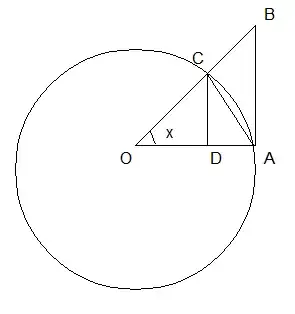Possible Duplicate:
Proving $\lim_{\theta \to 0}{\frac{\sin \theta}{\theta}}=1$ using $\frac{1}{2}r^2(\theta-\sin \theta)$
How can one prove that $$\lim_{\theta \to 0} \frac{\sin\theta}{\theta}=1$$
$\sin(0) = 0$
Possible Duplicate:
Proving $\lim_{\theta \to 0}{\frac{\sin \theta}{\theta}}=1$ using $\frac{1}{2}r^2(\theta-\sin \theta)$
How can one prove that $$\lim_{\theta \to 0} \frac{\sin\theta}{\theta}=1$$
$\sin(0) = 0$
$\lim_{\theta \rightarrow 0} \frac{\sin(\theta)}{\theta} = \lim_{\theta \rightarrow 0} \cos(\theta) = 1$ by L'hopital's rule.
For sufficiently small positive values of $\theta$:
$$\sin \theta \leq \theta \leq \tan\theta$$
This can be shown geometrically (picture is from here):

The area of $\Delta OAC$ is $\frac 12 \cdot 1 \cdot \sin x=\frac 12\sin x$. The area of the circular sector $AOC$ is $\frac x2$. The area of triangle $\Delta OAB$ is $\frac12\cdot 1\cdot \tan x=\frac 12\tan x$. Noting that these shapes are contained within each other (and rewriting the variable $x$ as $\theta$ for consistency), we write
$$\frac 12\sin \theta\leq\frac \theta2\leq\frac 12\tan \theta$$ $$1\leq\frac{\theta}{\sin\theta}\leq\frac 1 {\cos\theta}$$ $$\cos\theta\leq\frac{\sin\theta}{\theta}\leq1$$
Take $\lim_{\theta\to 0^+}\cos\theta$ and apply the squeeze theorem. Just flip the inequalities around in the first line for the negative case. When you go to the second line by dividing by $\sin\theta$, which is negative then $\theta$ is negative, the rest of the argument proceeds the exact same way.